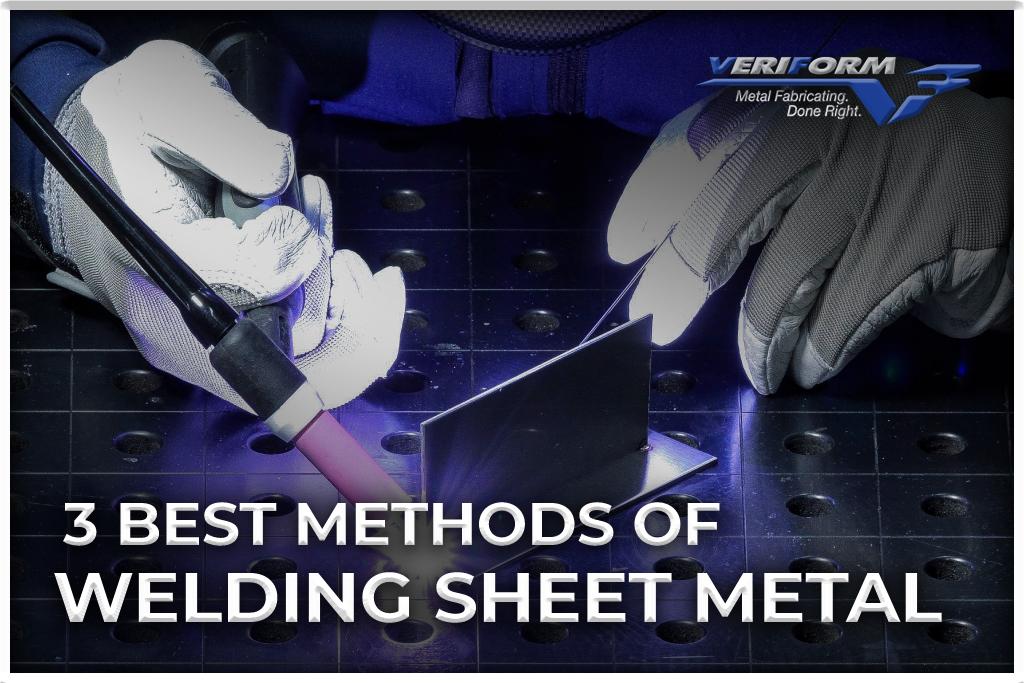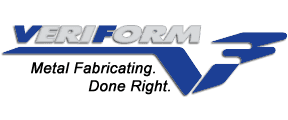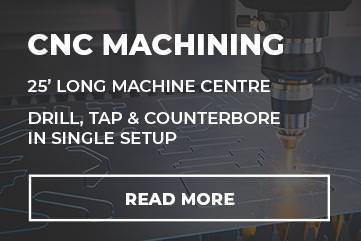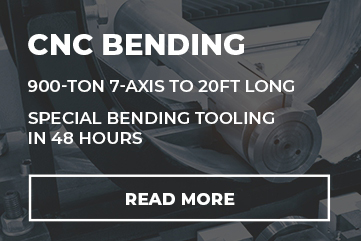News
3 Best Methods of Welding Sheet Metal

When you’re working with sheet metal, the welding procedure you choose can determine the success of your project. If you don’t use enough heat, the weld penetration will be subpar and you can get brittle joints. Too much heat and you risk burnout.
At VeriForm, Inc. we handle sheet metal using the latest and most advanced versions of proven welding technologies. In this article, we go over the 3 best methods of welding sheet metal, along with recommended applications for each one.
Gas Tungsten Arc Welding
Gas tungsten arc welding (GTAW), or TIG welding, uses tungsten electrodes that cannot be consumed. The tungsten electrode generates an arc that provides heat for welding. Filler material is often used to reinforce and build up welds. As with MIG welding, which will be discussed in the next section, a gas shield protects the pool from contaminants.
Depending on the filler size and how the filler wire is applied, TIG speeds range from 7” to 15” per minute. This method is not normally used on carbon steels due to its comparatively slower speed. However, it may be applied if the size of your MIG gun prevents you from accessing the weld.
- Stainless Steel: Because of its clean appearance, TIG is primarily used on stainless steel. It is important to control heat input and speed when TIG welding stainless steel because it is prone to warping when heated unevenly. Unless the adjoining material requires brushing after the weld, there is usually no post-weld cleanup.
- Aluminum: For many years, TIG has been the standard process for working with aluminum. For thicker materials, a preheat cycle may be required to ensure complete penetration of the weld. Filler metal is used in the weld puddle, so the speed is generally slower than MIG.
Gas Metal Arc Welding
Gas metal arc welding (GMAW), also known as MIG welding, uses a continuous solid wire electrode fed through a welding gun. When the contact tip is electrically charged, it melts the wire and creates a weld pool between the two components. A shielding gas protects the pool from environmental contaminants that could cause defects. Due to the spatter that is created during welding, MIG is best used for projects in which cosmetics and weld appearance are not important.
GMAW manual weld speeds vary according to the weld size and location, but they are generally around 30″ per minute. Throughput can be increased by using robotic welding. GMAW welding yields the best results on materials like the following:
- Stainless Steel: For stainless steel sheet metal, Pulse MIG welding reduces spatter. The electrode does not come into contact with the pool during Pulse MIG welding. An electrode adds molten metal to the pool with each pulse of the current, which alternates between a high and low level.
- Carbon Steel: For carbon steel, MIG welding is preferred over TIG welding due to its speed. It can also be used to join parts that do not fit closely together. Typical weld examples include outside corners that require dressing.
- Aluminum Sheet Metal: To achieve a TIG-like weld appearance with aluminum, a pulse MIG machine is used with a special assist gas. The surface scale on aluminum must usually be removed before welding to avoid dust and splash marks.
Shielded Metal Arc Welding
Also known as stick welding, shielded metal arc welding (SMAW) uses a consumable electrode with a metal rod at its core. The arc formed between the electrode and the base metal produces the heat required. Disintegrating flux coatings release vapors that act as shielding gases and provide a protective layer of slag. Both prevent atmospheric contamination of the weld area. During the welding process, the metal rod inside the electrode melts, forming a molten pool that creates the weld.
You can control several variables that affect the width and height of the weld bead, the amount of spatter, and the penetration of the weld, making SMAW welding results easier to control. Stick welding is also more cost-effective than other methods, such as TIG. With its portability and versatility, it can be used in any position and with any thickness of sheet metal.
There are some downsides to SMAW welding, such as slag created during the welding process and slower speeds (3” to 6” per minute), but as your proficiency develops these issues are easier to control.
- Stainless Steel: Stick welding stainless is easy in flat and horizontal positions, but uphill, it can be challenging. Metal drops seem to fall off faster when the rod gets hot, the arc force seems to drop, and the bead crowns. To avoid these problems, set the amperage at the lower range of the required heat level so that the rod doesn’t get too hot and deposit metal at a more rapid rate.
- Carbon Steel: Stick welding is compatible with all grades of carbon steel, from 0.30 to 0.90%. Depending on the grade, it may need preheating and post-welding heat treatment to prevent cracking.
- Aluminum: Aluminum is more complicated to stick weld than steel, and the results may not be as aesthetic as you’d like, but it can still be done. Aluminum’s high thermal conductivity and low melting point pose many welding challenges, so you need to apply more heat to the weld pool although the melting point is lower. Getting the right heat requires varying the amperage output on your stick welder, and you’ll need to keep a shorter arc. Be sure to use moisture-sensitive electrodes designed for working with aluminum.
Is It Better to TIG or MIG Weld Sheet Metal?
Sheet metal comes in different varieties, some of which are more suited to one welding method than another. If you’re working with stainless steel, TIG welding will yield the clean visual results you’re looking for. You won’t want to use it on carbon steel, though, because it’s a comparatively slower process.
MIG welding, on the other hand, doesn’t yield attractive results on stainless steel. If you’re working with aluminum, you’ll want to use a MIG machine with a special assist gas. With carbon steel, however, MIG is the recommended approach due to its higher speed.
VeriForm Inc.: Your Sheet Metal Welding Experts
For every project, VeriForm Inc. employs only CWB-certified CSA W47.1 and W59 welders, along with a certified welding engineer. Our on-staff CWB-certified welding supervisors will also supervise your work to ensure the best results for your project. Let us use our experience and in-house efficiencies to prepare and ship your welded sheet metal products, so you have them when you need them. To learn more, please visit our website, call 519-653-6000 or contact us online.








